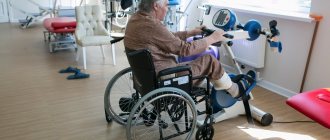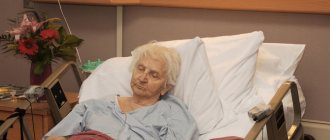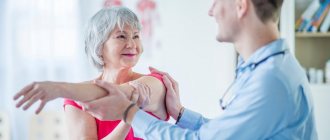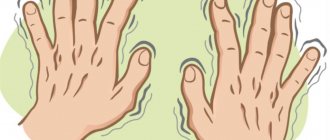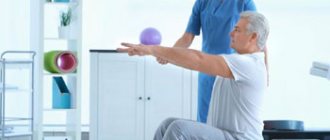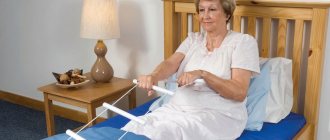Rehabilitation at home » Stroke rehabilitation at home
Our medical center provides rehabilitation services after stroke at patients' homes.
Stroke is a group of pathologies that are characterized by impaired cerebral circulation. Most often, people are affected by ischemic stroke, or cerebral infarction.
The second most common stroke among strokes is cerebral hemorrhage, which is no less dangerous. Another small proportion refers to the so-called subarachnoid hemorrhage.
Home rehabilitation services
| Name of service | Cost, rub.) |
| Visit of a neurologist with preparation of an individual rehabilitation program | From 5 000 |
| Departure of a neurologist – Ph.D. with the preparation of an individual rehabilitation program and consultation (prescribing medication) | From 10 000 |
| Departure of the Doctor - exercise therapy | From 4 000 |
| Departure of a Doctor - Therapist | From 5 000 |
| Departure of a doctor - Cardiologist | From 5 000 |
| Departure of a doctor - Physiotherapist | From 5 000 |
| Visit of a doctor - Urologist | From 5 000 |
| Departure of a doctor - Neuropsychologist | From 4 000 |
| 1 lesson with a doctor – Neuropsychologist | From 4 000 |
| 1 lesson with a physical therapy instructor | From 3 500 |
What is rehabilitation based on?
In order to quickly return a person to normal life, or at least minimize the consequences of a stroke, doctors have developed various rehabilitation methods. They are based on movement, since after a stroke a person loses the ability to move - as a rule, one half of the body is affected.
Medical science has long established that our brain is the center of the body, which controls the functioning of all other organs. It may seem to a person that he moves his arms and legs as a matter of course, but this is not the case.
Any movement is a set of impulses that are transmitted from the brain to the muscles, causing them to move. During a stroke, the supply of blood to brain cells and, as a result, oxygen and nutrients is disrupted. Cells die in huge numbers - much more than, for example, when drinking alcohol or from any diseases.
From a stroke, cells die in entire foci that are responsible for the functioning of a particular organ. However, this does not mean that such a person can be given up.
Millions of healthy cells remain in the brain, which are not used in “normal” life, or perform other functions. It is these that need to be developed in order to regain lost motor ability. Moreover, it is quite possible to do this, since stroke manifests itself differently in different people. Some people have difficulty speaking, others have limited arm movement, and still others have problems with their legs. In any case, hidden reserves in the body can always be found.
The most important thing is to approach the rehabilitation process correctly. Essentially, the body will have to relearn how to perform simple functions, but the results will be worth it.
To put it simply, during rehabilitation after a stroke, the process is reversed. In a healthy person, the brain controls the activities of the entire body.
During the rehabilitation process, the patient, under the guidance of a doctor, “develops” the body, and it, in turn, “forces” the brain to work in a new way. It’s not for nothing that doctors recommend playing sports to improve health. Even if a modern person cannot find time for full-fledged training, he needs at least jogging or walking in the fresh air.
Physical activity is the key to health, which is confirmed not only by athletes, but also by research by doctors. Therefore, by forcing an arm or leg to move, a person stimulates the activity of millions of nerve endings. The same can be said about restoring speech function, since there are a lot of facial muscles, and it is impossible to make them work again in any other way other than movement.
Of course, carrying out all kinds of procedures requires energy expenditure. Something from which a person previously did not experience even a hint of fatigue, during rehabilitation after a stroke can become a difficult task that will require all the body’s strength. Therefore, the rehabilitation process involves taking medications that will nourish the nerve cells with energy. This is normal practice, since treatment of the consequences of a stroke requires a comprehensive approach due to the seriousness of the disease.
What is the rehabilitation process like after a stroke?
Before recovery from a stroke begins, the patient must undergo a thorough medical examination.
First of all, the diagnosis is carried out by a neurologist and a physical therapy doctor (PT). Further, depending on the degree of damage to the body, other doctors are involved in the treatment - for example, a therapist, a traumatologist, a surgeon and others. Examinations and tests are carried out in order to exclude complications that may arise during treatment procedures.
Diagnostics includes daily cardiograms to determine the heart’s ability to withstand certain loads, as well as ultrasound examination (ultrasound). It is necessary in order to assess the level of potential danger of blood clots during treatment.
When all diagnostic measures have been completed, doctors select the optimal recovery course. Depending on the characteristics of the body and the severity of the stroke, the course activities may vary. Some patients first need to learn how to control their breathing correctly, while others learn to walk again from the very first procedure.
Often, exercise alone is not enough for successful rehabilitation after a stroke.
For more effective recovery, doctors have developed special simulators and equipment that stimulate the functioning of muscles and nerve cells. They act on the muscles mechanically, preventing them from stagnating and maintaining their volume.
In addition, such devices improve blood flow and reduce pain, since it cannot be said that after a stroke a person completely ceases to feel a particular part of the body. The group of auxiliary materials also includes “passive” means. These include all kinds of corsets, tapes, bandages, etc., which fix the damaged limb in a certain position, replacing the functions of the joints and muscles.
Unfortunately, the rehabilitation process does not always allow a person to fully regain the abilities lost during a stroke. In this case, the doctors’ task is to bring him as close as possible to this, and in a broader sense, to show that a bright and rich life is possible even after a stroke, if you believe in yourself and receive support from others.
Motor rehabilitation after stroke
The main method of rehabilitation of patients after a stroke with movement disorders (paresis, impaired coordination and statics) is physical therapy. Its tasks include full or partial restoration of range of motion, strength and dexterity in paralyzed limbs, balance function in ataxia, and self-care skills.
In the rehabilitation clinic, in addition to exercise therapy, patients are prescribed electrical stimulation of the neuromuscular system of paralyzed limbs and are given classes using the biofeedback method. Physical therapy exercises begin as soon as the patient regains consciousness and improves his general condition. At first it is passive gymnastics. Movements in all joints of the limbs are performed not by the patient, but by the exercise therapy instructor or relatives instructed by him. The patient is taught breathing exercises. Exercises are carried out under the control of pulse and blood pressure with mandatory pauses for rest.
In the future, the exercises become more complicated, the patient begins to sit down, and then is taught to sit down independently and get out of bed. The timing of patient activation is determined by many factors:
- severity of stroke (size of infarction or hemorrhage, dislocation of brain structures, amount of edema);
- general condition of the patient;
- severity of paresis;
- hemodynamic state.
Some patients begin to get up from the 3-5th day after a stroke, in other cases they begin to become active after 2-3 weeks. An important stage of rehabilitation is learning to stand and walk. In patients with severe paresis of the lower limb, this stage is preceded by an imitation of walking while sitting in a chair or lying in bed. The patient learns to stand first with the support of a rehabilitation therapist, then independently, holding onto the headboard or bedside frame. At the same time, it evenly distributes body weight onto the healthy affected leg.
Subsequently, the patient learns to walk. Start by walking in place. Then the patient walks around the ward supported by a bedside frame, then learns to walk independently using a three-legged or four-legged cane. With good stability, the patient is immediately taught to walk using a stick.
Only with good balance and moderate or mild paresis of the leg can the patient begin to walk independently without relying on a stick. The volume of movements and distance gradually increase: the patient first walks around the ward or apartment, then along the corridor and up the stairs. After this, he can go outside and use transport.
Some patients with mild impairments “skip” many stages of rehabilitation and immediately begin to walk independently over relatively long distances, while others stop at certain stages. When a paralyzed foot drops, patients are recommended to wear shoes with high, rigid fastenings. To prevent stretching of the shoulder joint bursa in a patient with severe paresis of the arm while walking, it is recommended to fix the arm with a scarf, removing it during exercise therapy.
Rehabilitation after a stroke at home
Recovery after a stroke is a long process during which a person cannot stay in a medical facility all the time. This takes several months - public hospitals cannot always accommodate all patients, and treatment in private clinics is too expensive. On top of everything, a person who has suffered a stroke wants to spend more time with his family and friends.
Stroke most often affects older people or middle-aged people who already have families. The desire to be close to them is understandable, since a stroke is not only a physical illness, but also a serious psychological trauma.
The optimal solution in this case would be to conduct rehabilitation after a stroke at home. It does not require constant hospitalization, but at the same time is carried out under the supervision of a doctor.
Of course, the patient must periodically undergo diagnostics in the clinic, but this is much easier to tolerate than constantly being in a hospital ward.
Stroke
Preliminary consultation and registration: +7 (495) 433-11-30
Specialist doctors draw up an individual rehabilitation program for each patient, taking into account the specific course of the disease, the medical and psychological needs of the patient, home and family nuances. Our medical workers do not just carry out the necessary procedures - they care about the internal well-being of their patients, they know how to show tact and understanding, and persistently and patiently help overcome the consequences of such a serious illness as a stroke.
The rehabilitation program after a stroke at home lasts from two weeks to one month, depending on the required intensity of exercise:
"Intensive" (5 times a week / 1 month)
Program cost: 59,000 rubles
"Recovery" (5 times a week / 2 weeks)
Program cost: 33,500 rubles
“Optimal” (3 times a week / 1 month)
Program cost: 39,000 rubles
A multidisciplinary team works with the patient: exercise therapy doctor, neurologist, exercise therapy instructor. If necessary, the patient can be examined and advised by a surgeon, nephrologist, endocrinologist, cardiologist, therapist, or psychotherapist.
Rehabilitation at home has a number of advantages compared to being in a hospital:
- the recovery process is faster: the patient’s familiar environment and being among loved ones relieves him of stress and discomfort; recovery at home allows the patient to avoid an inconvenient and traumatic transfer to a medical facility
- home rehabilitation programs are significantly lower in cost than hospital stays, since treatment and rehabilitation procedures and consultations with specialists are directly paid for. The cost of a hospital includes a fee for the stay, hospital expenses for renting and maintaining premises, payment for expensive equipment (which in the vast majority of cases can replace mobile equipment)
- in home rehabilitation, the full range of therapeutic measures is used (physical therapy, massage, physiotherapy, mechanotherapy), as well as training in necessary household skills and handling of those everyday objects that the patient is used to using; family members can observe the entire rehabilitation process and also participate in it , receiving the necessary information about the patient’s health status and how to properly provide assistance and care
- In addition, it is worth noting that not all patients have access to hospital care for medical reasons.
The consequences of a stroke are not only a medical problem, but also a social one: the treatment of this disease, as well as its prevention, depends on an integrated approach and long-term measures that require the participation of loved ones and rehabilitation specialists. Not every medical institution is able to take care of such events, but not every family knows that restoration of functions impaired by a stroke is possible and necessary.
Inability to recognize the signs of a stroke, late hospitalization, lack of intensive care units and rehabilitation programs in hospitals - all this leads to the fact that stroke is one of the causes of disability in the population.
Meanwhile, step-by-step rehabilitation programs developed by specialists can help a person gradually return to normal life and independence. Timely professional assistance significantly speeds up this process. But even if the first months, so valuable for rehabilitation, were missed, you should not give up. Of course, it will take a lot more time, effort and patience, but a positive result from such efforts is still possible.
Stroke is an acute disorder of cerebral circulation; in old age, this is most often an ischemic stroke - a person’s motor and speech functions suffer, memory, thinking, and emotions are negatively affected.
How is recovery work at home structured? At the first stage, this is primarily concern for the general condition of the patient, massage, and regular but not tiring physical exercise. Over time, classes related to speech restoration, self-care skills, and memory training are added. Exercises to restore the accuracy of small movements and coordination are important.
In general, rehabilitation programs for patients who have suffered a stroke already have years of successful practical application behind them and are therefore quite standard. But it is worth keeping in mind that the success of their use largely depends on two factors: control by medical specialists, compassion and enthusiasm of people who regularly communicate with the patient (health workers, relatives). Of course, the patient’s attitude is also important, but the disease can damage areas of the brain responsible for a person’s emotions and behavior, so recovery after a stroke also affects these areas.
Programs aimed at speech restoration:
"Twelve" (3 times a week / 1 month)
Program cost: 39,000 rubles
"Sixteen" (2 times a week / 2 months)
Program cost: 49,000 rubles
Programs aimed at restoring cognitive functions (memory, attention):
"Eight"
Program cost: 24,000 rubles
A speech therapist (or clinical psychologist) and a medical specialist (neurologist, exercise therapy doctor) work with the patient.
All specialists have valid professional certificates and experience in the field of rehabilitation.
- If you want to learn more about our programs and services, please call our consultant: +7 (495) 433-11-30 (daily from 8 to 20 hours)
- Licenses
Results of rehabilitation procedures after stroke
In our Multidisciplinary Treatment and Rehabilitation Center, you or your relatives can receive consultations with doctors for rehabilitation after a stroke at home.
Thanks to the measures developed by our specialists, you will notice improvements in your health in a short time after starting the procedures. Our comprehensive program is aimed at restoring the following body functions:
- Improving cerebral circulation
- Restoring the functions of the spine as the main “pillar” of the human body. If the spine is able to keep the body straight, other activities will be easier
- Restoring motor functions of the injured hand
- Restoring musculoskeletal functions of the injured leg
- Restoration of step phases, that is, events during which a person actually learns to walk again
- Restoration of speech function, work with a speech therapist
- Restoration of primary household skills
- Normalization of psycho-emotional background
Basic principles of exercise therapy after stroke
The early start of rehabilitation measures, which are carried out at the Yusupov Hospital, helps to speed up the pace and make the restoration of impaired functions more complete, and prevent the development of secondary complications. Exercise therapy for stroke (acute cerebrovascular accidents) begins in the neurology clinic and is subsequently carried out in the rehabilitation clinic. After discharge from the hospital, patients continue to perform physical therapy exercises at home under the supervision of rehabilitation specialists.
The patients themselves and their family members take an active part in the recovery of patients after a stroke. Rehabilitation specialists compile a set of exercise therapy exercises, teach methods of implementation, and teach how to monitor the functioning of the cardiovascular system during physical therapy exercises.
The very possibility of recovery is based on the general biological law of reorganization of functions - the ability to rearrange and participate in the restoration of the impaired function of those neuronal connections that were not previously involved in its implementation. The prognosis for recovery is determined by the volume and location of the lesion. The recovery of motor function is worse when the stroke is localized in the posterior thigh of the internal capsule, where the motor pathways converge into one bundle. Speech is restored more slowly when the pathological focus is located in both speech zones: in the posterior part of the left inferior frontal gyrus and the posterior part of the left superior temporal gyrus.
Active motor rehabilitation in most clinics is not carried out if the following contraindications are present:
- heart failure in the stage of decompensation;
- chronic angina pectoris at rest and exertion;
- renal failure;
- acute inflammatory diseases.
At the Yusupov Hospital, the rehabilitation process after a stroke involves a multidisciplinary team of specialists who use innovative methods of rehabilitation therapy. This allows patients with severe concomitant pathologies to get back on their feet and restore self-care skills.
Speech and motor rehabilitation is impossible if patients have dementia and mental disorders. Physical therapy for brain stem stroke is performed lying down. The exercises are aimed at restoring motor functions of the limbs. Over time, exercise therapy is prescribed for facial muscles and restoration of speech functions.
Rehabilitation techniques
Our methods are based on many years of experience in rehabilitation after stroke, as well as on our specialists’ own developments. Depending on the patient’s condition and the severity of the stroke, we provide treatment in the following ways:
- Verticalization. The most important technique, since it is precisely because of the immobility of the patient after a stroke that the greatest number of complications develop. Verticalization involves a process in which a person learns to take a vertical (at least sitting) position without outside help. In addition to the obvious “medical” advantages, the psychological factor is also important here, since it is much more comfortable for the patient to feel, literally, on the same level as relatives and doctors
- Mechanotherapy. It is a course of training on simulators aimed at restoring the motor functions of the affected limbs
- Physiotherapy. Conducted under the guidance of an instructor, and intended for patients in whose treatment there has been some progress
- Occupational therapy. This complex name is a technique that combines the knowledge and achievements of psychology, pedagogy, anatomy, biology and ergonomics. Occupational therapy sessions include special exercise equipment, group discussions, various games and even music therapy. The positive emotions that a person receives during these sessions have a beneficial effect on the rehabilitation process
- Sand treatment. Particles from the sand flow stimulate the excitation of nerve endings on the skin, and this information enters the brain. These feelings are only positive, so a person relaxes and gets rid of negative emotions
- Classes with a speech therapist. Necessary in cases where a stroke causes speech loss or impairment
- Working with psychologists. A stroke is a serious shock both for the person himself and for his relatives. During conversations with the doctor, the patient calms down and gains confidence in his abilities. This confidence on a subconscious level contributes to a speedy recovery, although the person himself does not think about it. For relatives of the patient, psychologists provide consultations on communicating with the patient outside the walls of the medical institution
- Drug treatment. Used to restore the vitality of the body and eliminate the consequences of a stroke
Typically, doctors prescribe several treatment methods from this list, which alternate with each other according to a specially developed program. The duration of this program is about three weeks. Procedures should be carried out at least three times a week for several hours a day. If this does not require special simulators, the procedures can be carried out at home according to the doctor’s recommendations.
Exercise therapy after a stroke
What's the point? Gentle, painless techniques allow the doctor to restore the balance between bones, muscles, ligaments, internal organs, and also normalize the circulation of cerebrospinal fluid.
Taking a course of therapeutic physical education: types of exercises and instructions for implementation. Stroke is a disruption of the blood supply to areas of the brain, in which the death of nerve cells occurs. Statistics show that 70-80% of patients have musculoskeletal disorders. As an aid to restoring motor activity, it is necessary to use rehabilitation measures, one of which is physical therapy. Exercise therapy for stroke is a set of exercises selected for each patient individually (taking into account the damaged areas of the brain and the degree of their impairment). It is recommended to perform a complex of exercise therapy for stroke regularly and in doses. The sooner the patient begins to perform a complex of exercise therapy, the greater the effect of treatment will be. Exercise therapy after a stroke: a set of exercise therapy exercises can speed up the recovery process. Regular exercise improves blood circulation in the organs, does not allow blood to stagnate in the vessels, promotes the creation and restoration of muscle memory, reduces muscle tone, prevents the appearance of restrictions on joint mobility (contracture), muscle wasting and spasms in them, bedsores, helps stop the transmission of false nerve impulses, which causes involuntary movements. Positive effects also include: -improving the functioning of the circulatory system in conjunction with the heart; - normalization of breathing processes; -stimulation of metabolism; -improving the patient's mental state. Physical therapy exercises after a stroke have an important goal - the inclusion of compensatory mechanisms to restore muscle memory. Thanks to repeated repetitions of exercises, new conditioned reflex connections arise. Remember: exercise therapy after a stroke at home cannot be fully provided unless a specialist is involved! Contraindications to exercise therapy Despite the gentle pace and caution of specialists, exercise therapy for stroke has contraindications to this procedure. Prescribing therapeutic physical training is prohibited in the following conditions: - the patient is in a coma; -high risk of recurrent stroke (most often observed in people over 70 years of age); - the likelihood of an epileptic seizure; -aggressive behavior, presence of mental disorders; - pressure above 180/105 mmHg. If a patient is admitted to the hospital with a hemorrhagic stroke, then physical education is prescribed at a time when the patient’s symptoms stop increasing and the functioning of the circulatory system and other organs is improving. It is recommended to perform breathing exercises and massage the limbs in the first 3 days from the start of classes. Preparation for the procedure The preparatory stage includes the following steps: - changing the position of the victim’s body in order to prevent stagnation of blood in the vessels; -passive loads for joints and muscles (for example: abduction-adduction of limbs, flexion-extension, i.e. work of antagonist muscles); -breathing exercises to restore lung function; -carrying out manual massage to restore blood circulation. This event will prepare the body for more active movements. It is important to remember that the above preparation steps should be carried out by a specialist and only if the patient’s life is not in danger. A physical therapy instructor at home after a stroke will help carry out preparatory measures. The importance of passive gymnastics Activities for passive gymnastics are prescribed after the patient regains consciousness. First, correction occurs by position, and the stroking method is used on the muscles affected by tone. Rubbing and kneading are also effective. Perform similar actions 2-4 times a day, up to 15 repetitions for each joint. The patient's response must be monitored. Breathing should not be interrupted, and there should be no pain. Exercise therapy specialists pay special attention to bedridden patients, since it is important to monitor the patient’s breathing. If the patient’s movements are difficult, then the larger joints are kneaded first. If there is no contracture, then it is customary to start with the distant (distal) parts of the limbs. To restore muscle memory, use muscle exercises. Not only physical movements are important, but also the message of action to the muscles. Commands can even be given out loud, for example: “I raise my leg up.” The psychological aspect is also important. In most cases, stroke patients feel depressed and weak. In such a situation, a physical therapy instructor after a stroke should encourage and praise every step along the path to action.
However, a stroke is accompanied not only by impaired limb movements, but also by speech dysfunction. This is why it is important to involve specialists involved in articulation. Classes with him should be regular. Additional conversations with the patient and reading aloud to him will not hurt. You shouldn’t be forced to pronounce sentences right away; you need to start with sounds, then move on to letters, words, and then combine them into sentences and short texts.
The role of active physical exercise exercise therapy: recovery after a stroke The main goal of active exercises is the restoration of previously formed and the creation of new acquired (conditioned) reflexes. It is necessary to achieve isolated body movements in the patient while providing little resistance. Typically, the exercise includes two phases - static (less mobile) and dynamic (more mobile). The static phase is aimed at muscle tension and developing the ability to support the limbs in a certain position. The mobile phase includes the movement itself, i.e. active work of the muscles of the limbs. However, even during the active phase of the exercise, a slow pace must be maintained so as not to cause pain to the patient. It is important to remember that with paralysis, fine motor skills are impaired. The stages of recovery depend on the amount of loss of movement function. If the movement of the limb is completely absent, then it is necessary to apply passive loads, and only then proceed to turning over flat objects (for example, playing cards, coins, writing letters and numbers). Exercise on an exercise bike will not hurt either, since it trains the cardiovascular system and restores motor skills of the lower extremities. If the patient has disturbances in the functioning of the bladder sphincter, then Kegel exercises are used - contraction of the striated muscles of the pelvic floor. In cases where the patient’s life is not in danger, the use of the yoga method will be effective. This usually happens after 6-7 months of recovery. Exercise therapy complexes after a stroke Exercise therapy after a stroke: restoring balance with vision An important aspect of recovery is the return to work of the extraocular muscles and auxiliary structures of the eye. The following exercises are usually used: 1. Squeezing and relaxing the eyelids - 10-15 times 2. Movement of the eyes to the sides, from bottom to top and top to bottom (performed with open and closed eyelids) 3. Fixing and holding the gaze at one point 4. Frequent blinking 5 Rotate your eyes clockwise and counterclockwise. Exercise therapy for the hand after a stroke If impaired motor skills of the hand are recorded, then flexion-extension of the fingers 10-15 times will be effective (performed on each hand). In order to strengthen the shoulder joints, it is necessary to perform the exercise in a lying position, and the side on which the patient lies should not be damaged. The specialist fixes the joint with his hand, and then slowly moves the injured arm away from the body with the opposite limb. In this case, the patient’s elbow and forearm should be in a “palm down” state (pronation), and the hand should be in a straight position. Then the hand rises, moves to the side and back. If the patient has injuries on both sides of the body, then the exercise is performed on the back. At the same time, the methodologist straightens the victim’s arm and moves it to the side. If the connection is established, small voluntary movements of the limb will occur. In this case, they move on to the next stage - raising and lowering the injured arm using a pulley apparatus of the healthy limb. Exercise therapy of the legs after a stroke In order to restore movements in the muscles and joints of the lower extremities, exercises are used such as: - abduction-adduction of the hip to the side and towards oneself - rotation in a circle (works the hip joint) - flexion-extension of the knee joints (performed in passive mode ) -flexion-extension of the knee from a lying position on the healthy side (in this case, the thigh must be extended. Performed in passive mode) -raising and lowering with the uninjured arm using a block with a cord -movements of the ankle (performed passively). It is important to note that the exercises begin with the uninjured limbs, and then use the alternating method with the paralyzed limb. The approach should be comprehensive: a combination of exercises with massage and relaxation of worked muscles. To learn more about the exercise program, you can watch a video of exercise therapy after a stroke at home. You can also find a specialist on the Internet by entering “stroke exercise therapy instructor” into the search bar.
